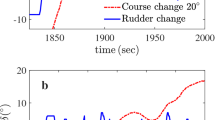Abstract
For damping the rolling motion of ship effectively and economically in rough sea, nonlinear feedback algorithm is implemented to control the fin stabilizer. Most of the researches paid attention to improve the performance of controller, while this paper turns attention to control the feedback error by a nonlinear function to reduce energy consumption. The controller and feedback error decorating constitutes to a kind of nonlinear feedback control. In rough sea, the controller which is designed by close-loop gain shaping algorithm can reduce the rolling angle by 51.67%. After decorating feedback error by a sine nonlinear function, the performance of controller is not affected, while the output of fin servo system is decreased by 13.6%. Obviously, the energy is saved.









Similar content being viewed by others
References
Somayajula A, Falzarano J, Lutes L (2019) An efficient assessment of vulnerability of a ship to parametric roll in irregular seas using first passage statistics. Probab Eng Mech. https://doi.org/10.1016/j.probengmech.2019.102998
De Oliveira MC, Kassar BDM, Coelho LCG et al (2019) Empirical and experimental roll damping estimates for an oil tanker in the context of the 2nd generation intact stability criteria. Ocean Eng. https://doi.org/10.1016/j.probengmech.2019.102998
Kianejad SS, Enshaei H, Duffy J, Ansarifard N, Ranmuthugala D (2019) Ship roll damping coefficient prediction using CFD. J Ship Res 2:108–122
Kianejad SS, Enshaei H, Duffy J, Ansarifard N (2019) Prediction of a ship roll added mass moment of inertia using numerical simulation. Ocean Eng 173:77–89
Kianejad SS, Lee J, Liu Y, Enshaei H (2018) Numerical assessment of roll motion characteristics and damping coefficient of a ship. J Mar Sci Eng. https://doi.org/10.3390/jmse6030101
Saripilli JR, Sen D (2018) Numerical studies on effects of slosh coupling on ship motions and derived slosh loads. Appl Ocean Res 76:71–87
Liang L, Wen Y (2019) Rudder roll stabilization with disturbance compensation model predictive control. J Mar Sci Technol 24:249–259
Lu J, Gu M, Umeda (2017) (2017) Experimental and numerical study on several crucial elements for predicting parametric roll in regular head seas. J Mar Sci Technol 22:25–37
Yıldız B, Katayama (2017) Bilge keel–free surface interaction and vortex shedding effect on roll damping. J Mar Sci Technol 22:432–436
Hirakawa Y, Hirayama T, Kakizoe K et al (2014) Sea trial of prototype vertical weight stabilizer (VWS) anti-rolling system foSr small ships. J Mar Sci Technol 19:292–301
Alujevic N, Catipovic I, Malenica S, Senjanovic I, Vladimir N (2019) Ship roll control and power absorption using a U-tube anti-roll tank. J Ocean Eng 172:857–870
Chang CM, Chang WJ, Ku CC, Hsu FL (2018) Passive fuzzy control for lift feedback fin stabilizer system of a ship via multiplicative noise based on fuzzy model. J Mar Sci Technol Taiwan. 26:159–165
Liang LH, Zhao P, Zhang ST, Yuan J (2018) Simulation analysis of fin stabilizers on turning circle control during ship turns. Ocean Eng 173:174–182
Zhao ZP, Zhang Q (2019) Adaptive self-regulation PID tracking control for the ship course. Chin J Ship Res 14:145–151
Hickey NA, Grimble MJ, Johnson MA, Katebi MR, Melville R (1997) Robust fin roll stabilization of surface ships. In: Proceedings of the 36th IEEE conference on decision and control, pp 4225–4230
Alarçïn F (2007) Internal model control using neural network for ship roll stabilization[J]. J Mar Sci Technol 15:141–147
Miao BB, Li TS (2016) A novel adaptive neural network control for fin stabilizer. Ship Eng 38:21–24
Li C (2018) Research and analysis of dynamic load of ship fin stabilizer. Ship Sci Technol 40:22–24
Zheng ZJ, Liang WZ (2017) Study on nonlinear system of ship fin stabilizer based on variable structure robust control. Ship Sci Technol 39:46–48
Guan W, Li X, Ren ZH, Sun JH, Zhang XK (2019) L_2 gain robust control for closed-loop shaping of ship fin stabilizers [J/OL]. J Harbin Eng Univ 12:1–7
Sun MX, Luan TT, Liang LH (2018) RBF neural network compensation-based adaptive control for lift-feedback system of ship fin stabilizers to improve anti-rolling effect. Ocean Eng 163:307–321
Wang XP, Zhang XK (2007) Fin stabilizer control based on feedback linearization and closed loop gain forming[J]. China Navig 04:5–8
Demirel H, Alarçin F (2016) LMI-based H2 and H∞ state-feedback controller design for fin stabilizer of nonlinear roll motion of a fishing boat [J]. Brodogradnja 67:91–107
Demirel H, Doğrul A, Sezen S, Alarçin F (2017) Backstepping control of nonlinear roll motion for a trawler with fin stabilizer. Int J Marit Eng 159:205–212
Zhang XK, Zhang GQ (2016) Design of ship course-keeping autopilot using a sine function based nonlinear feedback technique. J Navig 69:246–256
Zhang Q, Zhang XK (2017) Ship nonlinear-feedback course keeping algorithm based on MMG model driven by bipolar sigmoid function for berthing[J]. Int J Naval Archit Ocean Eng 9:525–536
Zhang XK, Yang GP, Zhang Q, Zhang GP, Zhang YQ (2017) Improved concise backstepping control of course-keeping for ships using nonlinear feedback technique. J Navig 70:1401–1414
Zhang XK, Zhang Q, Ren HX (2018) Linear reduction of backstepping algorithm based on nonlinear decoration for ship course-keeping control system. Ocean Eng 147:1–8
Jia XL, Yang YS (1999) Mathematical model of ship motion–mechanism modeling and identification modeling [M]. Dalian Maritime University Press, Dalian
Zhang XK, Wang XP (2004) A robust wave interference filter[J]. China Shipbuild 04:21–26
Zhang YN (2010) Nautical meteorology and Oceanography [M]. Dalian Maritime University Press, Dalian
Acknowledgements
This work is partially supported by the National Science Foundation of China (No. 51679024), the Fundamental Research Funds for the Central University (No. 3132019501), the University 111 Project of China (No. B08046), and the Natural Science Foundation of Liaoning Province (No. 20180520039). The author would like to sincerely thank the anonymous reviewers for their pertinent and instructive suggestions to improve the quality of this paper.
Author information
Authors and Affiliations
Corresponding author
Additional information
Publisher's Note
Springer Nature remains neutral with regard to jurisdictional claims in published maps and institutional affiliations.
About this article
Cite this article
Liang, C., Zhang, X. Concise and economical control implemented on ship fin stabilizer system based on nonlinear feedback algorithm. J Mar Sci Technol 26, 88–96 (2021). https://doi.org/10.1007/s00773-020-00723-8
Received:
Accepted:
Published:
Issue Date:
DOI: https://doi.org/10.1007/s00773-020-00723-8




